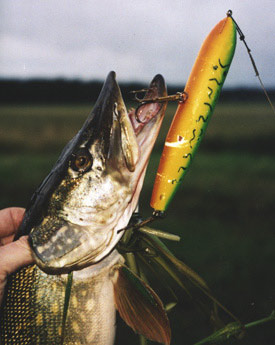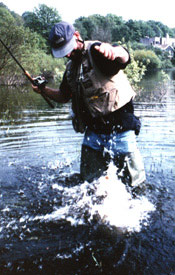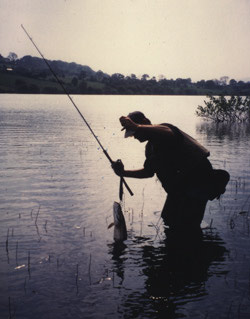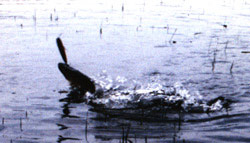 It
is always said that topwater lure fishing is the most exciting way to catch pike.
You know the sort of stuff I mean. Huge bow waves following your lures along the
surface until the pike grabs the bait and goes airborne as soon as it feels the
hooks. Or maybe one of those sudden explosive takes where the fish smashes the
lure without any warning and almost rips the rod out of your hands! Yeah, it can
be exciting stuff. It certainly gets your heart pounding at times, but it can
be mighty frustrating too.
It
is always said that topwater lure fishing is the most exciting way to catch pike.
You know the sort of stuff I mean. Huge bow waves following your lures along the
surface until the pike grabs the bait and goes airborne as soon as it feels the
hooks. Or maybe one of those sudden explosive takes where the fish smashes the
lure without any warning and almost rips the rod out of your hands! Yeah, it can
be exciting stuff. It certainly gets your heart pounding at times, but it can
be mighty frustrating too.
There
are few things that I am willing to guarantee in pike fishing, and this is one
of them - when you start using surface lures on a regular basis you will get a
lot of wild strikes, and you will lose, or at least fail to connect with, a lot
of pike! There have been times when I have been raising fish after fish
on topwaters, often when they wouldn't look at any other presentation, but failing
miserably to land any. Even after trying every trick in the book to make sure
a pike will actually take a lure well enough to get hooked. Why this should be
I do not know. It almost seems like the pike are not actually interested in eating
the lures, but are playing with them like a cat with a mouse.
One
thing is for sure, surface baits can annoy pike into striking to a much greater
degree than other lure types. There is something about the commotion that many
of these lures create that triggers some sort of response in pike. I know that
all waters are different, and that pike behave differently from place to place.
However, in my experience it is rare to see pike taking prey off the top. During
the spring and summer I see loads of small waterfowl skittering over the surface
of the waters I pike fish, and have yet to see one disappear in the middle of
a big swirl. Same goes for water voles. Neither can I recall ever having seen
a pike rocket skywards like the proverbial Polaris missile, except when going
for a topwater lure. I know some of you reading this will have witnessed the kind
of incidents that I have just described. But my point is this: pike attack surface
lures far more frequently than they do surface swimming prey.
As
I am convinced that it is some sort of annoyance factor that sets off the pike's
trigger when surface fishing I don't think that there is much to be gained from
trying to ascribe any imitative qualities to your surface lures. That is to say
you should be using topwaters to alert pike to their presence. There are times
when a subtle approach is called for; don't get me wrong, but trying to make your
lure look like a water rat or duckling is likely to be a waste of time.
Once
the water warms up with the first long warm days, usually in May, it is time to
give the surface baits a go in earnest. Rising water temperatures and spawned
out pike still hanging around the shallows, perhaps picking off spawning prey
fish, combine to give some excellent opportunities for topwater action. One of
the most productive times I have had with topwaters came when Martin McDerby and
I stumbled on just such a concentration of pike on a seventy acre reservoir. We
had entered a long spell of warm and sunny weather just after the pike had spawned
and they were packed in a large shallow bay into which the wind was blowing. These
conditions held for about a fortnight, and I think we found the fish just a little
too late to get the best out of the situation.
 There
were obviously bream in the shallow weedy bay, much of it less than three feet
deep and wadeable. So we initially started out in thigh waders punching Top Doctors
and Jackpots into the wind. At first the pike were being caught close in, actually
in the mares tails that were just starting to break surface, where the bream were
also active. This was great stuff, and although the pike were not large, the biggest
going about eight pounds or so, it was good fun to have them chase a lure in and
grab it under your rod end. Many times we had fish take and run back between us
and the bank. As anyone who has hooked pike in shallow water will tell you they
have only two options, to move away from you or take to the air. Aquabatics were
the order of the day!
There
were obviously bream in the shallow weedy bay, much of it less than three feet
deep and wadeable. So we initially started out in thigh waders punching Top Doctors
and Jackpots into the wind. At first the pike were being caught close in, actually
in the mares tails that were just starting to break surface, where the bream were
also active. This was great stuff, and although the pike were not large, the biggest
going about eight pounds or so, it was good fun to have them chase a lure in and
grab it under your rod end. Many times we had fish take and run back between us
and the bank. As anyone who has hooked pike in shallow water will tell you they
have only two options, to move away from you or take to the air. Aquabatics were
the order of the day!
At
the outset these pike were pretty easy, but after a couple of sessions, and all
we were doing was a few hours of an evening, they moved out a ways. It was then
essential to get the lures out from the weed edge. So chest waders were called
for. Fishing stickbaits when stood waist deep in water is not too easy, but by
working the rod tip to one side makes it feasible. Now we could reach the pike
in the slightly deeper water. I remember standing there with the wind blasting
into the bay, water lapping at the top of my waders and pike launching themselves
at my lop Doctors. Great stuff! At least handling pike when wading is easy and
they never need to leave the water. Keep your pliers or Hookout to hand, even
on a lanyard so they don't go the way of one pair of braid blades I dropped!
What
was apparent during this brief period, and what has become obvious on other waters,
is that pike soon wise up to surface lures, stickbaits in particular. It only
took about four sessions before I had to resort to using subsurface lures to elicit
a response from the pike. Shortly after that they moved out and dispersed around
the reservoir.
 While
we were enjoying this sport it didn't seem to make any difference what colour
of lure we threw, so long as it had a good 'walking' action. Black, yellow or
orange, it didn't seem to matter despite clear water and bright sunshine. This
is something that I think holds for surface lures in most cases (although I am
sure to be proved wrong at some point) - so use lures that you can see easily.
It was also obvious that the rippled surface, at times quite choppy out on the
main body of the water, didn't put the pike off. Surface lures are frequently
associated with flat calm conditions, but here and elsewhere I have found a bit
of a blow to be advantageous. Just make sure that you kick up a lot of fuss with
your baits. Slow crawlers and subtle presentations are not recommended. Your topwaters
must make more noise than the waves in order to be noticed.
While
we were enjoying this sport it didn't seem to make any difference what colour
of lure we threw, so long as it had a good 'walking' action. Black, yellow or
orange, it didn't seem to matter despite clear water and bright sunshine. This
is something that I think holds for surface lures in most cases (although I am
sure to be proved wrong at some point) - so use lures that you can see easily.
It was also obvious that the rippled surface, at times quite choppy out on the
main body of the water, didn't put the pike off. Surface lures are frequently
associated with flat calm conditions, but here and elsewhere I have found a bit
of a blow to be advantageous. Just make sure that you kick up a lot of fuss with
your baits. Slow crawlers and subtle presentations are not recommended. Your topwaters
must make more noise than the waves in order to be noticed.
Again,
most people might not associate bright sunshine with surface activity, but it
can get pike going at times. At the other end of the scale I have had good results
at both dawn and dusk. Here too lure colour is relatively unimportant so I have
started painting some of by topwaters black on the belly, and fluorescent yellow
or orange on the back. This gives them a crisp underside silhouette for the pike,
and a hi-vis top for me to follow their progress. Now, while I like a big noisy
stickbait for working quickly over the wave tops, I will slow it right down in
low light levels. Sometimes leaving quite lengthy pauses between taps with the
rod. Keep it quiet too, merely rippling the cairn surface rather than making the
lure splash loudly. Even though the lure might be working in a subtle way, the
takes can be far from subtle.
 Pike
take surface baits in many ways. They will actually hit them like rockets and
head skywards with the lure in their jaws. At other times they will roll on them
hardly breaking the surface. However the lure is hit you should not strike or
nine times out of ten you will pull the lure out of the pike's mouth. It takes
some doing, but wait until you feel the weight of the pike before leaning into
it to set those hooks. I know it is easier said than done. I still get it wrong
from time to time!
Pike
take surface baits in many ways. They will actually hit them like rockets and
head skywards with the lure in their jaws. At other times they will roll on them
hardly breaking the surface. However the lure is hit you should not strike or
nine times out of ten you will pull the lure out of the pike's mouth. It takes
some doing, but wait until you feel the weight of the pike before leaning into
it to set those hooks. I know it is easier said than done. I still get it wrong
from time to time!
Given
low light levels, maybe even complete darkness, I tend to pick Out a crawler rather
than a stickbait. My preference is for the Hawg Wobbler which, once tuned by bending
the lip up or down, can be worked dead slow and creates quite a commotion. Not
only does the big Colorado lip push a lot of water, but the joint of the lure
can also be heard clicking as it waddles along. The slower you can fish this lure
the more likely you will be to connect with takes. This applies to all surface
baits as pike are not blessed with very good guidance systems. Pike will strike
behind topwaters three or four times during a retrieve. If a fish misses in this
way, slow the lure down and you might make contact if it is still interested.
The
Hawg Wobbler and other crawler type lures are easy to fish because they do all
the work. All you have to do is cast them out and wind them in. Make sure that
your hooks are super sharp and hang on! Stickbaits, on the other hand, need working.
Once you have got the knack of the short taps required to kick the bait off '-40
one side and then the other, you can start to break up the retrieve and trigger
more strikes. A steady rhythmical retrieve, even a super fast one, will raise
plenty of pike. I have found that pike that chase a speedy surface lure and turn
away or miss it rarely take a second look. The reverse being the case with a slow
retrieve, and an erratic retrieve is best of all being the one most likely to
trigger a positive strike. It is always worth pausing a lure, and this applies
just as much to surface baits as it does other lure types. Giving it a violent
rip as you restart the retrieve can pay off too.
There
are other surface lures around but these two are the most consistent producers
in my experience. They can also be used in other ways to provide the kind of action
that chuggers and poppers produce. There are not many good sized chuggers on the
market. A shame because I like them for drawing strikes from pike that are lying
up in weed, streamer weed for example. If you can't find a decent chugger try
using the Hawg Wobbler, or even a floating Burt or a big, buoyant minnowbait.
Chuck
your chosen chugger into a gap in the weed lying on the surface, let it rest,
then rip it with a sharp snap of the wrist. The lure will bloop and gurgle making
a hell of a racket and throwing up bubbles and spray. Sometimes it will get nailed
big time too! If not, let it sit again and, repeat the procedure. Two or three
chugs are enough as takes usually come straight away. Overdoing things can have
a negative result. Leave the spot and try it again later.
I
have got little to say about tailspinning surface lures, propbaits and buzzers.
They are useful for searching water as they can be fished quickly. I know others
catch on these lures, but all I get are off-target strikes or fish that turn away
at the last minute. Spinning type baits can be fished stop-start style, a bit
like ripping a popper,to kick up a lot of commotion in fitful bursts. This can
be more successful, although I prefer to use a chugger to fish like this. However,
I have not written these lures off and during the summer usually carry an Awaker
around just in case! Once you gain confidence in using surface lures they will
soon become the first lure you throw during the hot lazy days of summer.
(This
article first appeared in Pike and Predators)

